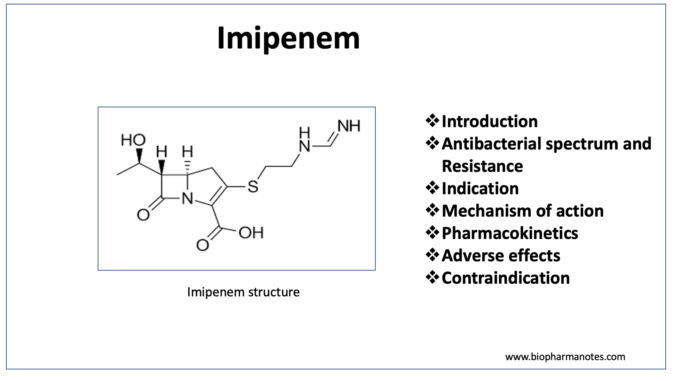
- Imipenem belongs to class of drug called carbapenems– a group of beta-lactam antibiotics with broader spectrum of activity and great potency compared to other beta-lactam antibiotics. Carbapenems are closely related to penicillin. The slight difference in structure is sulfur atom of thiazolidine ring of penicillin is externalized and replaced by a carbon atom in carbapenem. This carbon is responsible for carbapenem’s potency, spectrum of activity and stability against β-lactamase.
- Imipenem is synthetic, N-formimidoyl derivative of thienamycin which is first discovered carbapenem. It go its FDA approval for its medical use in November 1985.
- It is commonly used in combination with cilastatin. Also included in World Health Organization’s List of Essential Medicines.
Antibacterial spectrum and resistance
- It has wide spectrum of activity against beta-lactamase producing gram-positive, gram- negative and anaerobic bacteria including streptococci, enterococci, staphylococci, Listeria, most strains of Pseudomonas and Acinetobacter and B. fragilis.
- It is also effective against many multiresistant strains including penicillin-resistant S. pneumoniae, penicillinase producing Staphylococci strains and few strains of methicillin- resistant Staphylococci.
- Carbapenem resistance is current ongoing major health problem. Resistance to imipenem and other carbapenems may develop due to intrinsic or acquired resistance mechanism or both. The acquired mechanism to develop resistance to carbapenem include- porin mediated resistance to reduce uptake of carbapenem, efflux pump which pump carbapenem out of the cell and enzyme mediated resistance via carbapenemase genes. Carbapenemase can hydrolyze many beta-lactam antibiotics including carbapenems.
Indications of imipenem
- Combination of imipenem-cilastatin is used to treat various infection including UTI (urinary tract infection), lower respiratory infection, gynecological and intra-abdominal infection.
- Imipenem- cilastatin is also used in skin, bone, joint and soft-tissue infection.
- Used in treating serious infection caused by cephalosporin resistant nosocomial bacteria.
Mechanism of action of imipenem
- Its mechanism of action is like other beta-lactam antibiotics. It penetrates bacterial cell wall and bind to enzymes known as penicillin binding proteins (PBPs) which are located on cell membrane. Transpeptidase is one of the PBP involved in synthesis of peptidoglycans. Binding of imipenem to transpeptidase inhibits synthesis of peptidoglycans which leads to weakening of bacterial cell wall. Hence, the bacteria become vulnerable to rupture by solutes in surrounding medium resulting in death of susceptible organism.
- Imipenem is resistant to hydrolysis by most of the beta-lactamases.
Pharmacokinetics of imipenem
- It is administered via parenteral route (IV, IM route) and is not absorbed orally. It is hydrolyzed by dipeptidase which is found in brush border of proximal tubule of kidney. Hence, it is used in combination with cilastatin- a renal dihydropeptidase inhibitor, to prolong its activity. Cilastatin doesn’t have any antimicrobial activity. It helps to prevent inactivation and toxicity of imipenem.
- Around 20% of administered drug bind to plasma proteins. The half-life of both imipenem and cilastatin is around 1 hour. Around 70% of drug is excreted unchanged in urine. Dosage adjustment is needed in renal patients.
Adverse effects
- It is generally well tolerated. Some common side effects include nausea, vomiting, allergic reaction and hypersensitivity. It can also cause pseudomembranous colitis, taste disturbance, thrombophlebitis, and transient elevation of liver enzymes.
- If used in large doses, it can cause convulsion and confusion. Risk of convulsion is high in patients with CNS lesion or with renal insufficiency. Chances of cross allergy with penicillin exist.
Contraindication
- Contraindicated in patients with known hypersensitivity to imipenem or other beta-lactam antibiotics.
- As it can cause convulsion, it is avoided in patient with meningitis.
- Avoided in patient with known history or present condition of seizures.
- Used with caution in kidney patients.
References
- https://go.drugbank.com/drugs/DB01598
- https://www.webmd.com/drugs/2/drug-2216/imipenem-cilastatin-intravenous/details/list-contraindications
- Drusano GL et al. An overview of the pharmacology of imipenem/cilastatin. Journal of Antimicrobial Chemotherapy. 1986; 18(Supplement_E): 79–92.
- Rodloff AC etal. Two decades of imipenem therapy. Journal of Antimicrobial Chemotherapy. 2006; 58(5): 916–929.
- Pharmacology and Pharmacotherapeutics. 24th edition.
- Goodman and Gillman Manual of Pharmacology and Therapeutics.
- Lippincott Illustrated Reviews Pharmacology, 6th edition.
- A Textbook of Clinical Pharmacology and Therapeutics. 5th edition.